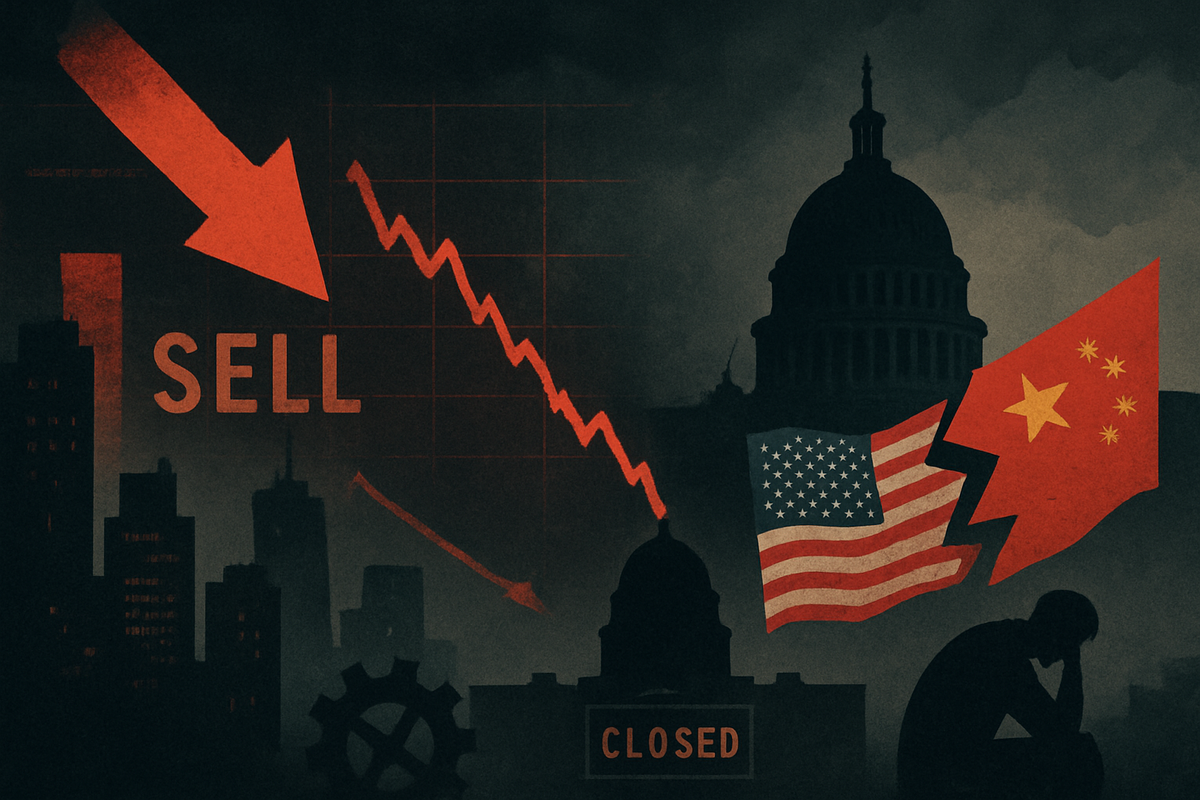
As of October 16, 2025, the global financial markets are grappling with a confluence of bearish indicators, prompting investors to exercise caution. Despite an underlying bullish sentiment buoyed by robust corporate earnings and an insatiable appetite for artificial intelligence, a series of 'sell' signals have emerged, casting a shadow of uncertainty over the stock market's near-term trajectory. These warnings stem from escalating geopolitical tensions, a softening domestic economy, and concerning technical chart patterns, suggesting that the S&P 500 (SPX) is at a critical juncture, poised for potential volatility if not a significant correction.
A Storm of Bearish Indicators Converges on Global Markets
The current market apprehension is a direct result of several intertwined factors that have intensified throughout October 2025. Geopolitical developments have taken center stage, with renewed US-China trade tensions proving to be a significant catalyst for market downturns. Threats of "massive" tariffs on Chinese goods, particularly concerning rare earth exports, emanating from the Trump administration in early October, triggered substantial sell-offs. On October 10, the Nasdaq Composite (NDAQ) plunged 3.5%, the S&P 500 (SPX) sank 2.7%, and the Dow Jones Industrial Average (DJIA) dropped 1.9% following these comments, marking one of the steepest single-day declines in recent memory. While hopes for a trade truce extension persist, the lingering specter of a full-blown trade war continues to fuel investor anxiety.
Adding to the domestic instability, a partial U.S. government shutdown, which commenced on October 1, 2025, has further clouded the economic outlook. This ongoing shutdown has not only delayed the release of crucial economic data, making it harder for investors and policymakers to gauge the economy's health, but has also raised concerns about its potential long-term damage to the U.S. economy. Key players involved include the U.S. government, particularly the executive and legislative branches, and major global economies like China, whose trade policies directly impact multinational corporations and supply chains. Initial market reactions have been characterized by heightened volatility, with the Cboe Volatility Index (VIX) showing spikes, and a noticeable flight to safety, evidenced by gold prices surging past $4,000 per ounce, reaching implied volatility levels not seen since April 2025.
Technical indicators are also flashing red. The S&P 500 (SPX) weekly chart saw a "bearish engulfing" bar form in the week leading up to October 12, signaling a potential reversal after a failed attempt at new highs. An intraday Head-and-Shoulders formation was also observed on October 16, typically a precursor to a downward move. Furthermore, the index briefly breached a bullish trend line on October 10. Momentum indicators like the Moving Average Convergence Divergence (MACD) are showing bearish crossovers for several individual stocks, indicating weakening buying pressure. A McMillan volatility band (MVB) sell signal was generated for the S&P 500 on October 10, underscoring increased realized volatility. While the weighted equity-only put-call ratio is on a sell signal, the standard ratio offers a conflicting buy signal, presenting a mixed picture from this particular sentiment gauge.
Economically, a softening labor market is a growing concern. Wage growth has moderated to 6.6% for job changers and 4.5% for those staying put in September, while the unemployment rate has crept up to 4.3% in October from 4% in January 2025. This has prompted the Fed funds futures market to price in a 100% probability of a 25-basis point rate cut in October and an 88% probability for another in December, indicating expectations for monetary easing. Federal Reserve Governor Christopher Waller recently highlighted the conflicting signals of solid GDP growth alongside a soft labor market, advocating for a cautious approach. Daily consumer spending data also points to falling momentum in tariff-sensitive goods and discretionary categories, which could pressure corporate earnings. Finally, significant liquidity strain was observed on October 16, with elevated DTCC repo rates and high transaction volumes, hinting at underlying pressures within the financial system.
Corporate Fortunes Diverge Amidst Economic Headwinds and Tailwinds
The current volatile market environment is creating a clear divergence in corporate fortunes, with some companies poised to weather the storm or even thrive, while others face significant headwinds. The interplay of geopolitical tensions, domestic policy paralysis, and shifting economic fundamentals means that strategic positioning and supply chain resilience are paramount.
Companies deeply embedded in the US-China trade dynamic are particularly vulnerable. China's expanded export controls on rare earth elements (REEs), coupled with President Trump's threats of 100% tariffs on Chinese imports and restrictions on "critical software," directly impact technology and semiconductor giants. Nvidia (NASDAQ: NVDA), Intel (NASDAQ: INTC), and Broadcom (NASDAQ: AVGO), along with Apple (NASDAQ: AAPL), face increased input costs, potential production delays, and supply chain disruptions due to their reliance on Chinese manufacturing and REEs. The US Senate's moves to block outbound investments in Chinese semiconductor, AI, and quantum sectors further complicate their operations. Even Taiwan Semiconductor Manufacturing Company (NYSE: TSM) could be affected if China's controls extend to essential materials for its US-bound chip sales. Similarly, manufacturing companies and defense contractors like Boeing (NYSE: BA), which rely on Chinese raw materials for components such as F-35 avionics, anticipate higher costs and potential assembly issues. Electric vehicle producers such as Tesla (NASDAQ: TSLA) are also at risk of production cuts due to potential shortages of rare earth minerals crucial for batteries and electric motors. Conversely, non-Chinese critical minerals and rare earths companies like MP Materials (NYSE: MP) could see increased demand as nations seek to diversify their supply chains away from China.
Domestically, the ongoing U.S. government shutdown is inflicting immediate pain on small businesses and government contractors, who face delayed payments, halted contracts, and disrupted access to essential government services. Industries reliant on government data, such as real estate, also suffer from delayed information. Companies requiring regulatory approvals, for instance from the EPA, will experience prolonged operational delays due to agency backlogs. While major US stock indexes have shown surprising resilience in the early days of previous shutdowns, a prolonged closure could "muddy the waters" for financial markets, impacting a broader range of companies through reduced consumer spending in areas with high concentrations of federal employees.
The softening labor market, characterized by slower job creation and easing wage growth, presents a mixed bag. Consumer discretionary and retail sectors, exemplified by companies like Beyond Meat (NASDAQ: BYND) which has seen significant stock drops, are likely to lose as reduced consumer spending dampens demand. However, companies with high labor costs could benefit from lower wage pressures, potentially improving profit margins. Firms focused on efficiency and "structural cost removal," such as J.B. Hunt Transport Services (NASDAQ: JBHT), are well-positioned to capitalize on a less competitive labor market. Companies undertaking restructuring, like Nestlé (SIX: NESN), which announced significant layoffs, might also see positive market reactions as they streamline operations.
Finally, the Federal Reserve's anticipated interest rate cuts, following a 25-basis point reduction in September 2025, are poised to be a significant tailwind for rate-sensitive sectors. Technology stocks, particularly AI-driven firms such as Nvidia (NASDAQ: NVDA), Broadcom (NASDAQ: AVGO), and Salesforce (NYSE: CRM), are expected to benefit from lower borrowing costs, which encourage business expansion and investment. The real estate sector and homebuilders are also set for gains, as falling mortgage rates improve affordability and stimulate buyer activity; homebuilder sentiment has already risen to its highest level since April. Companies with high debt loads will see reduced interest expenses, boosting their profitability. Conversely, while major banks like JPMorgan Chase (NYSE: JPM), Bank of America (NYSE: BAC), Morgan Stanley (NYSE: MS), and Wells Fargo (NYSE: WFC) have reported strong earnings, a prolonged cycle of rate cuts could compress Net Interest Margins (NIMs) for local banks, posing a future challenge for the broader banking sector.
Broader Implications and Historical Echoes
The current market tremors are not isolated incidents but rather symptomatic of deeper shifts in global economic and geopolitical landscapes. These events are accelerating existing trends towards de-globalization and economic fragmentation, intensifying the technological race, and forcing central banks to navigate unprecedented monetary policy dilemmas.
The escalating US-China trade tensions are a prime example of this broader trend towards de-globalization, signaling a strategic pursuit of economic self-sufficiency and decoupling. This rivalry, characterized by aggressive tariffs and export controls on critical technologies like semiconductors and rare earths, is reshaping global supply chains. Companies across industries, from defense to electric vehicles, are being compelled to diversify their sourcing and manufacturing away from China, leading to significant investment in new regional hubs and a re-evaluation of global operational strategies. The ripple effects are profound: increased input costs, production delays for multinational corporations, and potential inflationary pressures globally, reminiscent of the supply chain snarls seen during the early 2020s pandemic. Analysts suggest that China's rare earth restrictions alone could lead to double-digit wholesale inflation. This economic fragmentation also fosters a more multipolar trade environment, with countries like Mexico and Vietnam emerging as crucial "connector countries" in redesigned supply networks.
The ongoing US government shutdown underscores persistent partisan disagreements over federal spending, highlighting a broader challenge to fiscal stability in major economies. Each week of the shutdown is estimated to shave billions off US GDP growth, primarily through delayed government services, furloughed workers' lack of pay, and reduced consumer spending. The U.S. Chamber of Commerce has voiced significant concern over the accumulating harm to small businesses and unrecoverable economic growth. Historically, while short shutdowns have had minimal economic impact, prolonged impasses, like those in 1995-1996 or 2013, demonstrate the potential for substantial GDP reductions. The current administration's contemplation of mass federal employee layoffs, however, would be an unprecedented action, potentially causing a much more severe and lasting impact on the labor market than seen in prior shutdowns.
Meanwhile, the softening labor market, observed not just in the US but globally, signals a post-pandemic rebalancing. The International Labour Organization (ILO) forecasts increasing pressure on job creation beyond 2025 due to a global economic slowdown and geopolitical frictions. This trend, coupled with slightly elevated inflation, presents a complex monetary policy dilemma for central banks like the Federal Reserve. Their proactive interest rate cuts, aimed at stimulating employment and preventing a sharper economic slowdown, are occurring in a rare economic scenario. This balancing act requires careful monitoring to prevent unintended inflationary pressures or financial instability. Regulatory bodies are also intensifying their scrutiny of geopolitical risks, urging financial institutions to adopt more agile risk management strategies and navigate an increasingly fragmented regulatory environment, especially concerning emerging technologies like AI.
The enthusiasm surrounding Artificial Intelligence (AI) continues to drive significant investment and growth, particularly for technology giants. However, warnings about a potential "AI investment bubble" echo historical market exuberance, drawing parallels to the dot-com crash of 2000. While current analyses suggest a systemic financial crisis from this potential bubble might be less likely given that present AI investment is not as heavily debt-funded as past bubbles, the risk of a sharp correction remains. This intense technological race, marked by US-China rivalry in semiconductors and advanced combat systems, forces companies to align with national priorities and manage heightened geopolitical risks, further emphasizing the shift from purely free trade to an era where economic security and strategic advantage are paramount.
Navigating the Crossroads: What Comes Next for Markets
The immediate and long-term trajectory of the stock market and the S&P 500 (SPX) hinges on the delicate interplay of these powerful economic and geopolitical forces. Investors and businesses alike must prepare for a landscape defined by continued volatility and the necessity for strategic adaptation.
In the short-term (next 6-12 months), sustained market volatility appears almost certain. The specter of renewed US-China trade tensions, with threats of further tariffs, has already proven its capacity to trigger sharp market declines. Analysts at Morgan Stanley (NYSE: MS) have warned that lingering trade uncertainty could lead to an 8-11% decline in the S&P 500. While historical data suggests U.S. government shutdowns often have minimal long-term negative impact on the S&P 500, the current prolonged shutdown, causing significant weekly economic losses and halting crucial data releases, could temper economic momentum and investor confidence. The Federal Reserve's anticipated rate cuts, following the September 2025 reduction, are intended to stabilize the economy by lowering borrowing costs and stimulating demand. However, their effectiveness could be challenged by persistent inflation or a significant deterioration of the labor market, potentially pushing the economy into a "no hire, let's fire" environment. Despite these headwinds, strong corporate earnings, particularly from AI-driven technology and financial sectors, continue to provide some underlying resilience to the S&P 500, suggesting a mixed and unpredictable near-term outlook.
Looking into the long-term (1-3+ years), the global economy appears to be settling into a "new, more mercantilist era" marked by prolonged geopolitical and trade uncertainty. This implies that US-China tensions will likely remain a persistent source of volatility, reshaping global supply chains and potentially leading to a global economic environment with higher, more volatile prices as the pace of globalization slows. Governments are reordering policy priorities, with fiscal and trade policies taking center stage over purely monetary ones. If the Fed's rate cuts successfully support growth without reigniting inflation and trade visibility improves, some optimists, like Goldman Sachs (NYSE: GS) in July 2025, have projected an 11% rise in the S&P 500 over 12 months. However, a more pessimistic view warns that rising tariffs, falling corporate profits, and a cooling housing market could push the economy into a deeper slowdown, potentially forcing the Fed into more aggressive easing by early 2026, or even leading to stagflation or a debt crisis if the US fiscal situation deteriorates significantly.
To navigate this complex environment, strategic pivots and adaptations are crucial. Investors are advised to maintain a long-term perspective, ensure diversified asset allocation, and consider adjusting traditional defensive strategies. "Bias-adjusted Quality" and "tail-risk-managed Low-Volatility" approaches are suggested for better performance during downturns. Opportunities may emerge in cyclical and value-style investments, which tend to be less sensitive to trade policy uncertainty due to higher domestic revenue generation. The continued optimism around AI-related mega-cap companies also presents thematic investing opportunities. With falling cash yields due to Fed rate cuts, investors may need to reassess high cash allocations and shift into targeted bonds with higher yield potential, especially in the short-to-intermediate space and select credit exposure. Given the potential decline of "US exceptionalism," global investors are increasingly looking to diversify into non-dollar investments as valuations outside the US may become more attractive.
Market opportunities include the ongoing AI-driven growth, particularly in the semiconductor sector (e.g., Nvidia (NASDAQ: NVDA), Taiwan Semiconductor Manufacturing Company (NYSE: TSM)), and potential stability in defensive sectors like healthcare. The high-yield market could also benefit from improved financing conditions for American companies due to rate cuts. However, significant challenges persist, including the direct negative impact of trade wars on corporate earnings, potential credit quality deterioration, and the risk of inflation persistence despite rate cuts. The outsized influence of a few mega-cap AI companies on overall equity market movements also means that traditional diversification benefits may be reduced, making the market vulnerable to shifts in these leading stocks.
Ultimately, three primary scenarios and outcomes could unfold: a "soft landing" with continued growth, where Fed cuts effectively mitigate slowdowns and trade tensions de-escalate, allowing the S&P 500 to reach new highs; a period of prolonged volatility and stagnation, where trade tensions and government shutdowns persist, keeping the S&P 500 within a constrained range with frequent corrections; or a recessionary downturn/stagflation, where escalating tariffs and a severely weakened labor market lead to a significant economic contraction and a substantial drop in the S&P 500. The future outlook remains highly uncertain, demanding agility and close monitoring of economic data and policy shifts from all market participants.
The Path Ahead: Vigilance in a Volatile Era
As of October 16, 2025, the financial markets find themselves at a critical juncture, buffeted by a confluence of powerful forces that demand vigilance and strategic adaptability from investors. The "sell" signals flashing across the market are not merely transient blips but rather indicators of deeper structural shifts and heightened geopolitical risks.
Key Takeaways: The market has endured a rocky period, marked by a sputtering AI-fueled rally and a notable drop in bullish sentiment. The escalating US-China trade war, with threats of extensive tariffs and rare earth export controls, has emerged as a primary driver of market volatility, erasing trillions in market value and threatening diplomatic relations. Domestically, the ongoing U.S. government shutdown, now in its third week, is inflicting economic costs and obscuring crucial data, though its immediate market impact has been surprisingly muted. Simultaneously, the softening U.S. labor market, evidenced by muted demand and moderating wage growth, has prompted the Federal Reserve to embark on an interest rate cutting cycle, with further cuts widely anticipated to support economic activity.
Market Moving Forward: The market's path forward will be highly sensitive to the resolution of these intertwined challenges. While the Fed's dovish stance provides a supportive backdrop for both equities and bonds by lowering borrowing costs, its effectiveness could be challenged by persistent inflation or a significant deterioration in the labor market. The resilience of the US economy, driven by consumer spending and AI-related capital expenditures, remains a positive factor. However, the ongoing geopolitical uncertainty and the US government shutdown introduce significant downside risks. Some analysts anticipate a final market dip before a major rebound into 2026, fueled by renewed lending activity and a more favorable policy environment, while others remain wary of high valuations and the potential for a deeper correction if trade tensions are not de-escalated.
Significance and Lasting Impact: This period signifies a profound shift from an era of relatively stable growth to one defined by heightened volatility and geopolitical risk. The US-China trade tensions are not merely temporary headwinds but signal a determined effort to decouple key supply chains, particularly in strategic resources like rare earths. This could lead to a more fragmented global order, new trading patterns based on geopolitical alignment, and potentially significant premiums on commodity prices. The Federal Reserve's proactive rate cuts, while intended to mitigate labor market risks, may also reflect underlying concerns about economic fragility, even as inflation remains slightly elevated due to tariffs. This could lead to a recalibration of investor expectations regarding monetary policy flexibility in the face of persistent inflation and slowing growth. Furthermore, the growing influence of retail traders, aggressively "buying the dip" and driving options trading volume, signifies a potentially new era of market behavior where collective individual action can accelerate movements and make traditional interventions more challenging.
What Investors Should Watch For: In the coming months, investors should closely monitor:
- Resolution of the US Government Shutdown: The duration and terms of the shutdown will dictate its broader economic and market impact.
- US-China Trade Developments: Pay close attention to any developments in trade negotiations, particularly regarding the threatened 100% tariffs and rare earth export controls. Escalation or de-escalation will significantly impact risk sentiment, commodity prices, and specific sectors like technology and semiconductors.
- Federal Reserve Policy and Economic Data: Watch for the Federal Reserve's upcoming rate decision on October 29 and subsequent meetings in December and early 2026. The pace and magnitude of future rate cuts will be crucial. Also, monitor alternative labor market indicators and inflation reports, which may be released with delays due to the government shutdown, for clues on the Fed's future direction.
- Labor Market Trends: Beyond headline unemployment figures (once available), look at metrics such as job vacancies, wage growth, and layoff rates for a clearer picture of the labor market's health and its implications for consumer spending.
- Geopolitical Stability: Broader geopolitical risks, including conflicts in the Middle East and elsewhere, continue to influence energy markets and global supply chains, adding risk premiums to oil prices.
- Earnings Season and Corporate Guidance: As the earnings season progresses, pay close attention to corporate profitability and guidance, especially from technology and AI-related companies, which have largely driven recent market gains. Any signs of weakness could be a significant sell signal.
- Diversification and Quality Assets: In a volatile environment, a focus on diversification across asset classes and geographies, and a preference for quality companies with strong fundamentals, can act as a hedge against policy uncertainty and market corrections. Safe-haven assets like gold and investment-grade bonds may continue to attract demand.
The market outlook for the remainder of 2025 and into 2026 is one of cautious optimism mixed with significant headwinds. Investors who remain vigilant and adaptable to evolving geopolitical and economic realities will be best positioned to navigate the challenges and capitalize on emerging opportunities.
This content is intended for informational purposes only and is not financial advice





